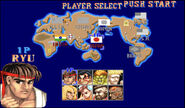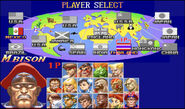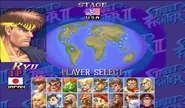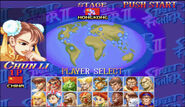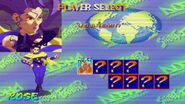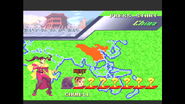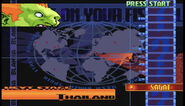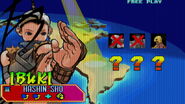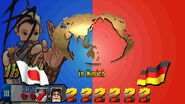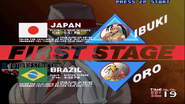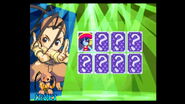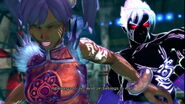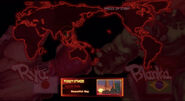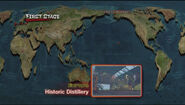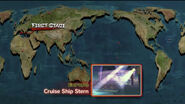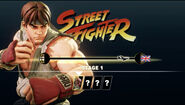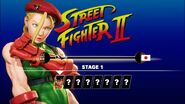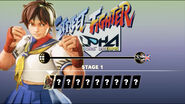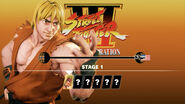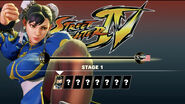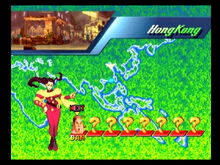
Rose taking part in Street Fighter Alpha 2's Arcade Mode, with her first opponent being Dan.
Arcade Mode is a game mode that has the player fight against random computer-controlled opponents in one-on-one close quarter combat. After a number of fights, they might fight a "rival", a character who has some kind of relationship with the chosen fighter, shortly before boss fights.
Description[]
Arcade Mode is a term used to describe the mode that is most often seen in arcade versions of the given game, but it has become synonymous with the format. In regards to this, and especially fighting games, Arcade Mode is regarded as something of a video game tradition, allowing for the player to experience a general display and presentation of the game's core gameplay for a straightforward intended experience. Since its establishment in early fighting games such as the first Street Fighter and Yie Air Kung Fu, most don't deviate to far from the format, often adding small additions.
Street Fighter[]
The first Street Fighter game allowed players to choose their first opponents. Only Ryu and Ken are playable, with the former being Player 1, and the latter being Player 2.
- At the beginning of the game, the player has to choose between four countries: Japan, the United States, China and England, with each country having two opponents to fight (Retsu and Geki, Joe and Mike, Lee and Gen, Birdie and Eagle, respectively).
- Once a country is cleared, the player will do one of four bonus stages, and then travel to the next country.
- Once the player defeats all eight default opponents, Ryu/Ken will travel to Thailand to face the sub-boss and final boss, Adon and Sagat.
Street Fighter II series[]
In the Street Fighter II series, the order of fights goes as so.
- Every playable fighter (excluding the Four Kings, and additional characters from Ultra Street Fighter II: The Final Challengers).
- The original version, Street Fighter II: The World Warrior, did not allow Mirror Matches, but later versions do.
- Later versions ( Super Street Fighter II: The New Challengers and later) randomly selects eight of all twelve non-boss characters as the opponents.
- Bonus stages strewn throughout the game (car destruction, barrel break, and fire barrels).
- Fights with the Four Kings in this order: Balrog, Vega, Sagat and M. Bison.
- Secret boss character Akuma, who can be fought in place of M. Bison (only in Super Street Fighter II Turbo and later versions).
Once Arcade Mode has been beaten, a character-unique ending is shown.
Street Fighter: The Movie (arcade)[]
- Every playable fighter, excluding the final boss.
- Final boss M. Bison.
- Secret mid-boss Khyber.
- In tag-team mode, the second-to last fight will be against two M. Bisons, and the last one will be against Super Bison.
Street Fighter: The Movie (console)[]
- Random fighters from the roster, excluding the final opponents (Zangief, Dee Jay, Sagat and M. Bison).
- Final boss M. Bison.
- Secret boss Akuma.
Street Fighter Alpha series[]
Street Fighter Alpha was the first series to have rival fights. The order generally goes as shown:
- Random fighters from the roster (excluding boss characters or rivals).
- A rival fight in the middle (or as the last fight in the original Street Fighter Alpha).
- Sub-bosses (Alpha 2 and 3) and final boss (which varies in the first two games, but in Alpha 3 is usually Balrog, Juli/Juni, then M. Bison).
- Secret mid-boss character Dan (Alpha only).
- Secret boss character Akuma (Alpha only).
- Secret boss character Shin Akuma (Alpha 2 only).
Street Fighter EX series[]
The Street Fighter EX series uses a straight-forward Arcade Mode, though EX2 Plus added bonus stages. Street Fighter EX3 does not feature a standard Arcade Mode, and has Original Mode in its place.
- Random fights from the roster (excluding boss characters).
- Bonus stages strewn throughout the game (Excel Break and Satellite Fall, EX2 Plus only).
- In the original Street Fighter EX and its updates, the final boss is M. Bison, with Akuma and a secret final boss, and Garuda as a secret mid-boss.
- In Street Fighter EX2, Garuda is the final boss, with Kairi and Shadow Geist as secret final bosses.
- In Street Fighter EX2 Plus, the final three opponents are Garuda, Sagat and M. Bison, with Kairi and Shadowgeist as secret mid-bosses, and Bison II as a secret final boss.
- In Street Fighter EX3, Kairi, Shadow Geist and Evil Ryu are secret bosses in Stage 5, depending on the character chosen. Bison II is also the final boss on Hard Mode and Shin-Bison is a secret final boss on said difficulty.
Street Fighter III series[]
The Street Fighter III series overall likely has the series' distinction of having the most distinguished arcade modes per installment. The original Street Fighter III: New Generation also had a straight-forward Arcade Mode. Street Fighter III: 2nd Impact features rivals midway and as the "true" final boss after Gill for some characters and brings a return to bonus stages from Street Fighter II. 3rd Strike offers the chance to choose from two random fighters for normal bouts instead of being chosen one by the game, sans rivals and the final boss.
- Random fighters from the roster (excluding boss characters or rivals).
- A rival fight in the middle (2nd Impact and 3rd Strike).
- Bonus stages strewn throughout the game (car destruction and parry practice, the latter being in both 2nd Impact and 3rd Strike, and the former being only in 3rd Strike). Can be disabled if the player wishes so.
- Final boss Gill.
- "True" final boss, being a rival depending on the character (2nd Impact only).
- Secret final boss character Shin Akuma (2nd Impact only).
- Secret mid-boss character Q (3rd Strike only).
Street Fighter IV series[]

An opening cinematic in the Street Fighter IV series.
Street Fighter IV is the first and only series to have animated prologues and endings.
- Intro animation.
- Random fighters from the roster (excluding boss characters or rivals).
- Bonus stages strewn throughout the game (barrel break and car destruction, Super Street Fighter IV onwards). Can be disabled if the player wishes so.
- Rival fight before boss (can switch between rivals by either pressing all three punches or kicks on some characters).
- Final boss Seth.
- Secret boss characters (Gouken, Akuma, Evil Ryu and Oni, the latter two being present from Super Street Fighter IV: Arcade Edition onwards).
- Ending animation.
Street Fighter V series[]
The original Street Fighter V did not have an arcade mode, but the first major update, Street Fighter V: Arcade Edition introduces one as the main feature.
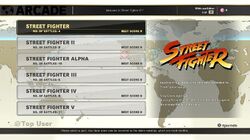
All the ladders in Street Fighter V Arcade Edition.
There are six different ladders to go through, each corresponding to a major game in the franchise. The player gets the choice to choose the next fighter from two, a returning element from Street Fighter III: 3rd Strike. There are over 200 arcade endings and each ending comes with a comic strip of what happened, similar to Capcom Fighting Evolution, so every character route in every ladder is completely unique. In some ladders (like the SFII and SFA ladder), instead of playing the stage theme, the theme of the opponent the player is currently fighting against plays.
At the end of each ladder, the player's total score is recorded on the Capcom Fighter's Network leaderboard. If the player's score is high enough, they will receive special titles to showcase on their profile page.
In the SFII and SFV ladders, a bonus stage appears after defeating the fourth and fifth opponent respectively, giving the player a chance to earn more points. In addition, the SFII ladder gives the player an opportunity to battle Shin Akuma as the final boss.
The SFIII ladder features Omega Gill as the final boss, who is equipped with both of his active V-Triggers. He also has his trademark Meteor Strike as his secondary Critical Art. Finally, if the player KOs Gill while his Critical Gauge is fully stocked, he can "Resurrect" himself to full health at the cost of all three meters.
The SFIV ladder features either Shin Akuma or Kage as the final boss. However, (depending on the ladder), the player must fulfill certain requirements in order to fight the final boss at the end of the ladder, such as winning a round with a Critical Art on three different opponents.
The SFV ladder also has certain requirements to face G as the New Challenger CPU opponent.
- Every playable fighter for the corresponding ladder.
- Bonus stages (SFII and SFV ladder only)
- Fights with Round 6 through 7 in this order: Balrog, Vega and Sagat. (SFII ladder only)
- Secret mid-boss G. (SFV ladder only for since Ver.03.060)
- Final boss character Sagat (SFI ladder for since Ver.03.060), M. Bison (SFII and SFA ladder), Urien (SFIII ladder for before Ver.05.001), Omega Gill (SFIII ladder for since Ver.05.001), Seth (SFIV ladder for since Ver.05.012) or the rival (Other than the above).
- Secret final boss character Shin Akuma (SFII and SFIV ladder only) or Kage (SFIV ladder only for since Ver.04.000).
All known fighters in each ladder[]
Below is the list of all known fighters to date.
- Street Fighter / Final Fight (four fights): Ryu, Ken, Birdie, Abigail, Zeku (standing in for Guy, possibly representing Geki and/or Retsu as well), Cody (possibly also representing Joe), Lucia (not appearing in original Final Fight, representing Haggar), Poison, Balrog (representing Mike), and Sagat.
- Street Fighter II (eight fights): Ryu, Ken, Chun-Li, Cammy, Guile, Blanka, E. Honda, Zangief, Dhalsim, Balrog, Vega, Sagat, M. Bison, Akuma.
- Street Fighter Alpha (ten fights): Nash, R. Mika, Karin, Cody, Sakura, Birdie, Kage (representing Evil Ryu), Dan, Rose, and all SFII characters (see above).
- Street Fighter III (six fights): Alex, Ibuki, Ken, Chun-Li, Kolin (originally non-playable during SFIII), Poison (originally non-playable during SFIII, standing in for Hugo), Urien, Laura (standing in for Sean), Akuma, Ryu, Oro and Gill.
- Street Fighter IV (eight fights): Juri, Ibuki, Poison, Cody, Sakura, Dan, Rose, Kage (representing Evil Ryu), Seth and all SFII characters.
- Street Fighter V (ten fights): All returning playable characters, and newcomers — excluding Season V bonus character Eleven (a mimic) — including: Rashid, Laura, F.A.N.G, Necalli, Kolin, Ed, Abigail, Menat, Zeku, Falke, G, Kage, Lucia, Akira, and Luke.
Street Fighter 6[]
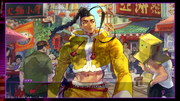
Jamie's intro in Street Fighter 6's Arcade Mode.
In Street Fighter 6, Arcade Mode is one of the two single-player modes (the other being World Tour). It also contains the game's Story Mode. It also features online rankings for the player's score. The player can choose 5 or 12 stages. After completing an arcade mode run, the player receives Kudos toward their selected character.
- Intro cutscene.
- Bonus stages strewn throughout the game (truck destruction and parry practice).
- Rival cutscene.
- Rival fight on the final stage.
- Ending cutscene.
- Special illustrations after the ending.
Just like in Street Fighter V: Arcade Edition, the player's total score is recorded on the Capcom Fighter's Network leaderboard. There is an Arcade Score leaderboard for 5 stages and 12 stages. If the player's score is high enough, they will receive special titles to showcase on their profile page.
Fighting EX Layer[]
Arcade Mode was not originally available; it was added on the 1.0.7 update.
- 6 battles against randomly selected opponents.
- Battle against the final boss, which depends on the character being used.
Gallery[]
Trivia[]
- Relating to Street Fighter V Arcade Mode’s routes:
- Although Evil Ryu appear in Ultra Street Fighter II: The Final Challengers, his represented character, Kage does not appear in Street Fighter II route.
- Although Akira’s home series, Rival Schools series takes place before certain Street Fighter Alpha games with its first game and its update took place before Street Fighter Alpha 2, while the second game took place before Street Fighter Alpha 3, she does not appear in Street Fighter Alpha route.
- Unlike Akira, Kage, Zeku and particularly Kolin, Ed, despite being debuted in Street Fighter IV, does not appear in its Arcade route, due to Ed still being a child in that storyline.
- Unlike other classic NPC characters prior to their first playable appearance in some later Street Fighter games (Kolin and Poison in Street Fighter III), Zeku, despite debuting in Street Fighter Alpha 2 acting as a standing in for Guy in Street Fighter Arcade route, he does not appearing in both Street Fighter Alpha and Street Fighter IV Arcade routes.
- Although Balrog was added in the first Street Fighter to act as a standing for the entry's debut character Mike, Vega was not included in there despite being based on the entry's debut character, Geki.
- Juri has a much larger role than Street Fighter IV protagonist, Abel, since she is the one who destroyed Seth's original body instead of Abel in that game (resulting in Makoto not getting the prize money she won from winning the tournament) and currently the only non-boss fighter from her debut entry (albeit from the updated version Super Street Fighter IV) who returned in Street Fighter V. Juri indirectly acts as a stand in for Abel on filling the role of Street Fighter IV's protagonist because Abel only returned as an NPC in Street Fighter V.


